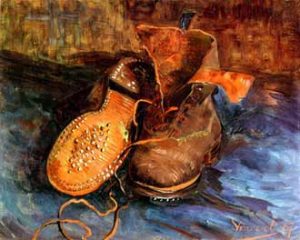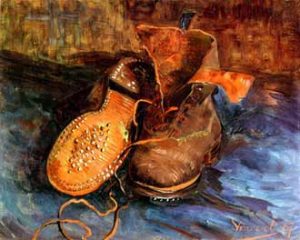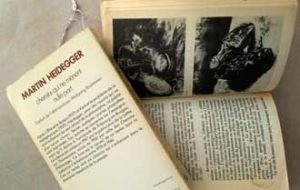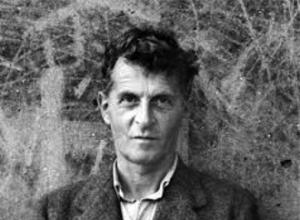
“Disappearance” is at the heart of the studies and novels of Hadrien Laroche, who reexamines for us “the thing” in the work of Martin Heidegger, Jacques Derrida, and Meyer Shapiro. We are familiar with the discussion around Van Gogh’s shoes, a still life lively enough to give rise to some very keen, contradictory interpretations. In introducing the Marquis de Sade into the game, the author allows us to broach the delicate question of the human being’s treatment as a thing by both artists and philosophers.
Laurence Bertrand Dorléac
> Hartung Bergman Foundation, Seminar August 2015
The Naked Thing: Parity, Restitution, Specters
Hadrien Laroche
“We should return to the thing itself,” writes Jacques Derrida in the first pages of his essay entitled “Restitution of the Truth in Pointing [pointure].” Nay, to the comicalness of the thing. The question of the thing is an old one, and many stories have been told on this subject. In the Introduction to What Is a Thing? Martin Heidegger, who takes the story from Plato, recounts that Thales is said to have fallen into a well while absorbed in the observation of the heavens. A good-looking and whimsical Thracian serving girl is said to have laughed at him for having been so passionate about obtaining knowledge of celestial things when “the things in front of his very nose and feet were unseen by him.” “The question ‘What is a thing?’,” writes Heidegger here, “must always be rated as one which causes housemaids to laugh.” And he adds, in perhaps a somewhat overdone way: “And genuine housemaids must have something to laugh about.”1

1. “A Pair of Shoes”, Van Gogh, 1887, oil on canvas, 34 x 41.5 cm, Baltimore, The Baltimore Museum of Art.
What about a pair of shoes? The “at home” motif—which contrasts a pair of town shoes and a pair of country shoes—really seems to be the determining schema for Derrida’s November 6, 1977 lecture devoted to Heidegger’s November 13, 1935 one on “The Origin of the Work of Art.” Derrida pointed out in a note that, as his pretext, he took an article by Meyer Shapiro, published under the title “The Still Life as a Personal Object: A Note on Heidegger and van Gogh,” which is presented as a critique of Heidegger and, more specifically, of what the latter says of Van Gogh’s shoes in “The Origin of the Work of Art.” A pretext for what? Derrida won’t say. What are Heidegger, Derrida, and Shapiro doing with Van Gogh’s shoes? These things are known. I remind you of the exhibits for this shoe-size trial [ce procès en pointure]:

2. Heidegger with Derrida, photo by HL.
A) Heidegger’s much-talked-about text, where we find a description of a picture by Van Gogh—which one? no one knows—that begins with:
A pair of peasant shoes [bauernschuhe] and nothing more. And yet— [New paragraph:] From the dark opening of the worn insides of the shoes the toilsome tread of the worker stares forth. . . . On the leather lies the dampness and richness of the soil. In the shoes vibrates the silent call of the earth . . .
And this passage ends with:
[It was] only by bringing ourselves before Van Gogh’s painting. This painting spoke. . . . It would be the worst self-deception if we were to think that our description, as a subjective action, had first depicted everything thus and then projected it into the painting. . . . But above all, the work does not, as might first appear, serve merely . . .2
This is an extraordinary moment of denial, therefore, during which Heidegger has leaped straight away over the domain of art in order to stand where he himself feels immediately at home.
B) The critique of Heidegger by Shapiro, who, with one thing gradually leading to another, first sees in Van Gogh’s painting a pair of town shoes, the painter’s own shoes, the body of Van Gogh, and even, according to Gauguin, whom he quotes, “a resurrected Christ.” Let us not laugh too quickly. This is what Derrida calls a “portrait of the artist as an old thing,”3 but he does not stop there. “These shoes are the face of Vincent,” writes Derrida paraphrasing Shapiro, “the leather of his aged, wrinkled skin, loaded with experience and weariness, furrowed by life and above all very familiar (heimlich),” with Derrida adding the German in parentheses. Shapiro, I must point out, makes a gift of this Christlike body to Kurt Goldstein. It was Goldstein to whom Shapiro had dedicated his text and it was he who had fled Germany in 1933, via Amsterdam, in the very place where Heidegger, three years earlier, had seen Van Gogh’s picture. In a May 6, 1965 letter to the American critic, who asked him had asked him when and where he had seen the picture, the German philosopher did indeed answer him:“in Amsterdam in March 1930.”
C) The least talked about and insistent criticism advanced by Derrida, who, with one hand and in order to avoid failing into the trap of these laces, of this law (which he saw without naming it), proposes the “argument-of-the-two-shoes” and performs what he again calls the “spectral analysis made of the pair.” This is an argument that, formerly, had greatly charmed me. “Is it really a pair?”4 the philosopher indeed asks himself, against all expectation in abyssal fashion! A question of parity arises:
When you assure yourself of the thing as of a pair, when you forget that detachment also goes from one shoe to the other and divides the pair, you repress all these questions, you force them back into order. . . . If there is a pair, then a contract is possible, you can look for the subject, hope is still permitted. A colloquy—and collocation—can take place.5
And therefore, with the other hand, he rightly underscores that Heidegger’s and Shapiro’s readings “come massively under ‘projection’ and” answer “to Heidegger’s pathetic-fantasmatic-ideological-political investments.”6
Before bringing these strokes together and telling about their law, the law of the thing, let us observe for a moment this “portrait of the artist as an old thing.” Here, I shall—by my own decision and through a leap—turn toward the Marquis de Sade. When one speaks of a thing, Sade is not far off—that is to say, the dark side of this very domination of reason from which Heidegger wants to snatch away the work of art, and from which, at bottom, neither he nor, moreover, Derrida or Shapiro can snatch it away. Sade reunited, in transgression, what Descartes has disjoined and what Immanuel Kant was able to knit back together only within a hierarchical connection between understanding and reason, namely, practical knowledge of the thing. In Naples, in January 1776, the Marquis saw at the Charterhouse of San Matino a Michelangelo Christ done, he writes, from nature itself, using a crucified model. “Upon inspection of the piece,” writes Sade in his Voyage d’Italie,
one easily recognizes that it could not be grasped, with the tone of truth it is, without the model actually being before one’s eyes, bound and gagged. What remains to be known is whether he really crucified him in order to seize, from nature itself, those precious moments of truth that can be found only there. Perhaps he would have done well to have done so in order to attain perfection. Yet that piece is not there, and consequently I do not believe that he would have done it because Michelangelo, like any other person, had some prejudices and prejudice was and always will be the stumbling block for true talent.7
Next, while he was, in the same city, at the Palazzo Farnese on Mount Posillipo, the Marquis saw a portrait done by Titian of his serving girl—there she is again—Sade pointed out, apropos of philosopher-artists and their right:
It is said that she [his serving girl] served him in more than one capacity: these are the kinds of physical furniture an artist and a man of letters cannot easily do without. It is good to have some of them here and there at one’s command; nature is satisfied and the head does not come off! Love is not made for a man who works.
This argument is to be found again in Justine, or The Misfortunes of Virtue (1791).8 What is this about? Art historians generally inquire here only about the provenance of this Michelangelo anecdote, which appears as a topos of art history. Let us leave aside the details. At no moment does one inquire about what at bottom is at issue: this obsessive daydreaming about slavery, namely, for the artist, the philosopher, nay the artist-philosopher, if not the writer, the vocation of treating the human being like a thing, which Sade calls physical furniture. This is the radical version of the fable of the serving girl and the thing. If I had the time, and the place, I would tell you of the genealogy of this inversion, from Michelangelo to Marcel Duchamp and on to 1970s performance art. Here, I shall limit myself to offering a hypothesis, namely, that, together with the fact that the end of art is the production of a thing through its creation, in a certain way the artist has as his vocation the treatment of the human being as some kind of material, nay, the treatment of himself as a thing. It is a game of massacres of which the artist is one of the figures.
“The work does not serve merely . . . ”; thus did Heidegger conclude his hallucinatory description of the picture of Van Gogh’s shoes. With a thing, it is its hallucination in painting that we are maintaining. Let us resume, starting with Heidegger:
Is it our opinion that the painting draws a likeness from something actual and transposes it into a product of artistic—production? By no means. The work, therefore, is not the reproduction of some particular entity that happens to be present at any given time; it is, on the contrary, the [restitution] of the thing’s very essence.9
Not the copy—which is still the motif to which Sade refers—but the restitution. That is what is at issue. Heidegger and Shapiro did not allow themselves the least doubt about the parity or the pairing of these two shoes, the condition for rendering justice to the truth they believed was due in painting. “There’s a law here,” Derrida advances.10 Might the philosopher of deconstruction be said to have escaped this law he does not name? Heidegger and Shapiro restitute the pair, that is to say, the thing—here to the peasant, there to the city dweller: they restitute it to the heimisch: the at home. What else does Derrida do if not restitute—he, too—the pair—to the unpaired [impair]? He restitutes the pair to the unpaired, the unpaired to the other, the other to the remainder, the remainder to the prosthesis, the prosthesis to the fetish, the fetish to the phantom. And so on and so forth—up to and including the specter. One could not do otherwise. This is the bet [pari] of the Unconscious. Derrida, too, confirms the truth of this law. And we are speaking of nothing else here. I call this law the law of the thing promised.11 One cannot refrain from restituting—from attributing the thing. “There is much to discharge, to return, to restitute, if not to expiate in all this,” writes Derrida.12 Certainly. This is the bent of he who believes that he owes the truth, in painting or in pointure. Better. As has been shown to us by Shapiro, to whom we must also give credit, one cannot refrain from rendering the thing, to a dead man. Here would be the fatum, if not the truth, of still lives as personal objects—the law of the thing promised [la loi de la chose due] Now, if it is due, it is damned [foutu], I would advance (and that would be almost the last word).
Would art be this serving girl reason mocks? See: La Joconde est dans les escaliers./Bin in zehn Minuten Zurück. Mona Lisa (Robert Filliou, 1969). It is not clear whether Heidegger is mocking the cleaning lady. She is right to think that there is a thing side in every work. Heidegger inquires:
The naked thing (blosse Ding) is a sort of product (Zeug) but a product divested (entkleidete) of its being-as-product. Being-thing then consists in what still remains (was noch übrigbleibt). But this remainder [Rest] is not properly [eigens] determined in itself.13
What about this remainder? We ultimately have been going around in a circle since the beginning: the shoes-product rests in itself as the thing pure and simple. And yet, even stripped of its utility, it is not the naked thing. Furthermore, the product reveals a kinship with the work of art inasmuch as it is manufactured by a human hand. Nonetheless, it does not have the self-sufficiency—the solitude—of an art work. So, the product is placed in a singular way between the thing and the work. Every creation, in the domain of art, is always also a product, but the opposite is not true. Ultimately, Being-work cannot be understood on the basis of being-as-product: conversely, it is only on the basis of Being-work that being-as-product becomes comprehensible. And what about the thing? Very simply, Heidegger has written here:
A man is not a thing. It is true that we speak of a young girl who is faced with a task too difficult for her as being a young thing, still too young for it [ein zu junges Ding], but only because we feel that being human is in a certain way missing here and think that instead we have to do here with the factor that constitutes the thingly character of things.14
Instead of asking ourselves what a thing is, we would finally be able to affirm what it is not—or, better, to say, with Heidegger: “A man is not a thing,” adding: nor are serving girls. Leaving the thing naked, itself.
Notes
1 Martin Heidegger, What Is a Thing? (1935-1936) trans. W. B. Barton, Jr. and Vera Deutsch with an analysis by Eugene T. Gendlin, (South Bend, IN: Gateway Editions, 1967), p. 3.
2 Martin Heidegger, “The Origin of the Work of Art,” in Poetry, Language, Thought, trans. Albert Hofstadter (New York: HarperCollins, 2001), p. 33, 35.
3 Jacques Derrida, “Restitution of the Truth in Pointing [pointure],” The Truth in Painting, trans. Geoff Bennington and Ian McLeod (Chicago and London: The University of Chicago Press, 1987), p. 370.
4 Ibid., 334, 360, 274.
5 Ibid., 334, 282.
6 Ibid., 311-12.
7 Marquis de Sade, Voyage d’Italie ou dissertations critiques, historiques et philosophiques sur les villes de Florence, Rome Naples, published in 1967, and quoted by Jean-Jacques Pauvert, in Sade vivant (Paris: Le Tripode, 2013) pp. 320-21.
8 Sade, Justine ou les Malheurs de la Vertu, Justine et autres romans (1791), Pléiade edition (Paris: Gallimard, 2014), p. 468 and note 948.
9 Martin Heidegger, “The Origin of the Work of Art,” p. 36. Derrida, p. 317. [Translator: My citation above of the Hofstadter translation has replaced a second appearance of “reproduction” in the last phrase with “restitution,” appearing there now in brackets in order to provide for the French word restitution, which does indeed appear in Wolfgang Brokmeier’s French translation, “L’origine de l’œuvre d’art,” for the 1962 Gallimard (TEL) Heidegger volume Chemins qui ne mènent nulle part, quoted by Laroche. (“Restitution” appears in italics above, and not just in brackets, because Laroche himself had added this emphasis in the written French text of his seminar talk.) Heidegger’s original German, however, simply employs Wiedergabe twice (see Holzwege, Gesamtausgabe: I. Abteilung: Veroffentlichte Schriften 1914-1970, Band 5 [Frankfurt am Main: Vittorio Klostermann,1977], p. 22; original p. 25 indicated marginally) and without italics. It may be noted that Wiedergabe can indeed mean both “reproduction” (in the artistic sense; or “rendering” in the musical sense) and “restitution” (or “return”). So, this interpolation in the French translation, not present in Hofstadter’s English translation, may be warranted—though it is unclear why reproduction was chosen the first time, without any indication or explanation, while restitution is given only the second time Wiedergabe (literally, “given again” or “given back”) appears in this sentence. Obviously, the interpolated use of the latter term, restitution, for Wiedergabe, is crucial to both Derrida’s and Laroche’s readings; restitution appears in the titles of both their texts here, and La Restitution is the title of Laroche’s 2009 Flammarion novel. My professional conscientiousness as a translator merely requires that I note for the reader the discrepancies between the German original and the French/English translations: in summary, it may be said that, in substituting restitution, the French silently fails to “reproduce” reproduction the second time Wiedergabe was given—the “giving again” does not occur at this crucial juncture involving Wiedergabe—and it “restitutes” restitution in this second act of translational “giving back”—whereas restitution wasn’t there to begin with, at least according to both the French and English translations.]
10 Derrida, p. 318.
11 Translator: In French: la loi de la chose due. The play on words here is between Heidegger’s “naked thing” (chose nue in French; see the next paragraph) and the chose due, as in the saying chose promise, chose due—which is usually rendered as “promise made, promise kept,” with no mention of things. Thus, in English, the contrast could be said to be between the nude thing—the thing stripped of everything but itself—and the thing due or as promised—the thing rendered to itself in keeping with the self-obligatory promise to do so.
12 Ibid., p. 273.
13 Derrida, p. 66-67. [Translator: Following Laroche, and in order to retain (in translation) the terms he employs as he subsequently comments this quotation, we have provided the version of this passage that appears, with various German terms in parentheses, in Derrida’s text. The Hofstadter translation, which appears on p. 30 of “The Origin of the Work of Art,” reads as follows:
The “mere,” after all, means the removal of the character of usefulness and of being made. The mere thing is a sort of equipment, albeit equipment denuded of its equipmental being. Thing-being consists in what is then left over. But this remnant is not actually defined in its ontological character.
Derrida’s interpretive version differs in several crucial terminological respects from the translation appearing in Chemins (cf. p. 29-30), which Laroche otherwise uses.]
14 Heidegger, “The Origin of the Work of Art,” p. 21.
Bibliography
DERRIDA, Jacques. The Truth in Painting. 1978. Trans. Geoff Bennington and Ian McLeod. Chicago and London: The University of Chicago Press, 1987.
HEIDEGGER, Martin. “The Origin of the Work of Art.” 1935-1937/1950/1960. In Poetry, Language, Thought. Trans. and Intro. Albert Hofstadter. New York: HarperCollins, 2001.
_____. “L’origine de l’œuvre d’art.” 1935-1937/1950/1960. In Chemins qui ne mènent nulle part. Trans. Wolfgang Brokmeier. Paris: Gallimard (TEL), 1962.
_____. What Is a Thing? 1935-1936. Trans. W. B. Barton, Jr. and Vera Deutsch with an analysis by Eugene T. Gendlin. South Bend, IN: Gateway Editions, 1967.
LAROCHE, Hadrien. Duchamp Déchets: Les hommes, les objets, la catastrophe, essai illustré. Paris: Éditions du Regard, 2014.
_____. La Restitution (novel). Paris: Flammarion, 2009.
SADE. Justine ou les Malheurs de la Vertu, Justine et autres romans. 1791. Pléiade edition. Paris: Gallimard, 2014.
_____. Voyage d’Italie ou dissertations critiques, historiques et philosophiques sur les villes de Florence, Rome Naples. Published in 1967. Cited by Jean-Jacques Pauvert. Sade vivant. Paris: Le Tripode, 2013.
Hadrien Laroche is a writer, philosopher and researcher. A former student at the École normale supérieure (Modern Letters), he has PhDs in philosophy and the Social Sciences (from the École des Hautes Études en Sciences Sociales). He is the author of essays—Le Dernier Genet, Histoire des hommes infâmes (Champs Flammarion, 2010) and Duchamp Déchets: Les hommes, les objets, la catastrophe (Éditions du Regard, 2014)—and fictional works—Les Orphelins (J’ai Lu, 2005) and La Restitution (Flammarion, 2009)—as well as, in 2015, Qui va là! (Rivages). He was the coorganizer of the colloquium “Heidegger and the ‘Jews’” at the French National Library (La Règle du Jeu, 58-59 [2015]). Currently in preparation are: Le Neveu de personne (fictional work) and Lettres philosophiques (essay).



